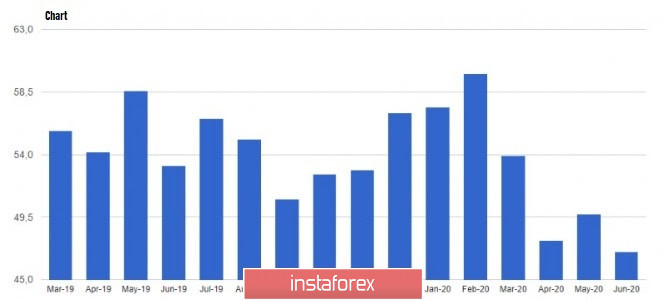The main news for today is the decision of the Fed on interest rates, and the assessment of further prospects for economic recovery after the coronavirus pandemic, which, by the way, is not over yet, judging by the latest data.

Many economists are expecting the Fed to announce the preservation of a soft monetary policy aimed at protecting the US economy from the effects of the coronavirus pandemic. However, such a decision will most likely add pressure on the US dollar, which has been declining recently due to problems such as weakening trade relations with China, unrest in the country and increased demand for risky assets. Nevertheless, what is important is the signals that the Fed will give regarding the short-term dynamics of economic recovery. Cautious statements and a penchant for aggressively soft policies are sure to negatively affect the US dollar.
The current rate of the EUR / USD pair has already taken into account the high demand for risky assets. New incentives and benchmarks are needed for the quotes to continue rising. Rumors are also circulating that the Fed plans to establish control over the yield curve of treasuries, but there is a high chance that this decision will not materialize.
With regards to the coronavirus, an increase in the number of new infections was observed in early June. The rise was recorded in 14 states, particularly in rural areas of the United States. It adds not only to the problems that the US authorities are facing, but also adversely affects the rate of the US dollar.
As for macroeconomic statistics, the reports published yesterday revealed that business sentiment in the US is now improving due to the mitigation of quarantine restrictions in the country. Thus, according to the data of NFIB, the Small Business Optimism Index rose to 94.4 points in May 2020, up from its 90 points in April. Economists expected a less active rise to 92.0, so the current value was a pleasant surprise. Anyhow, the improving sentiment reflects the opinion of small companies in the US, which account for almost half of the jobs in the country private sector. Most likely, this trend will lead to an improvement in the US labor market, which showed a significant rise in May this year.
Meanwhile, the data published by the Retail Economist and Goldman Sachs regarding retail sales in the US failed to influence the position of the US dollar. According to the report, the index grew by 4.4% over the week of May 31 to June 6, but fell by 12.6% compared to last year. The report of the Redbook, on the other hand, says that retail sales fell by 3.2% in the first week of June, and dropped by 9.7% year on year.
The IBD / TIPP poll, which reflects consumer sentiment in the United States, also fell by 5.4% in June, amounting to only 47.0 points. Index values below 50.0 indicate a predominance of pessimism, and the main reason for which is still the coronavirus pandemic.

As for the technical picture of the EUR / USD pair, the bulls will most likely attempt to continue the upward trend today, but the decisions of the Federal Reserve could prevent it. The central bank will surely note the recent improvements in the US labor market, and will revise some of the forecasts in this direction. Such a scenario will most likely increase the rate of the US dollar. In addition, if the data on inflation in the US comes out similar to forecasts, interest rates may remain at zero levels for a rather long period of time. Only a breakout from the resistance level of 1.1380 will raise the risky assets in the area of highs 1.1430 and 1.1490, but if the bulls fail to achieve it, the quotes will return to the level of 1.1300,
GBP / USD
The British pound continues to strengthen against the US dollar despite the lack of progress on trade negotiations between the UK and the EU. Many market participants expect that at a meeting next week, the Bank of England will increase its bond purchase program by another £ 100 billion, which could support the economy and raise the rate of the pound. The money will not only stimulate the different sectors of the UK economy, but also reduce the budget deficit in the country, which, due to costs associated with the coronavirus pandemic, has grown significantly.
The Bank of England is also set to lower interest rates to negative values, but before that happens, the regulator will resort first to other measures such as controlling the yield curve of government bonds. Since March 24, the Bank of England has already spent £ 144 billion, or 6.5% of GDP, on the purchase of government bonds. An increase in bond purchases will help avoid yield growth.
With regards to the coronavirus, the UK sees some possibilities of a second wave in the country, if the authorities and citizens fail to be vigilant. According to the London Institute of Hygiene and Tropical Diseases, the pandemic in the UK will be 2.5 times stronger if the British authorities completely resume schools and work, and cancel all the social distance measures. The quarantine restrictions in the country are now gradually being lifted, and part of educational institutions, as well as shops and catering outlets have already resumed work.
As for the technical picture of the GBP / USD pair, the demand for the pound remains quite high, the reason for which may be largely due to the weakening US dollar. A breakout from the resistance level of 1.2760 will raise the quotes to the highs 1.2840 and 1.2910, but if the bears fight on, and the decision of the Fed on interest rates lower the demand for risky assets, the nearest support levels on which the bulls can rely are in the areas of 1.2620 and 1.2530.
The material has been provided by InstaForex Company - www.instaforex.com